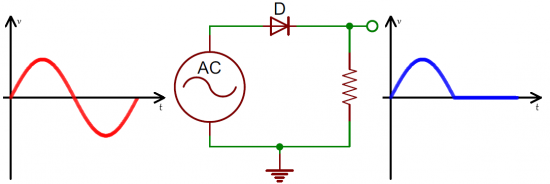The device and principle of operation of the diode
A diode is the simplest semiconductor device that can be found on the printed circuit board of any electronic device today. Depending on the internal structure and technical characteristics, diodes are classified into several types: universal, rectifier, pulse, zener diodes, tunnel diodes and varicaps. They are used for rectification, voltage limiting, detection, modulation, etc. — depending on the purpose of the device in which they are used.
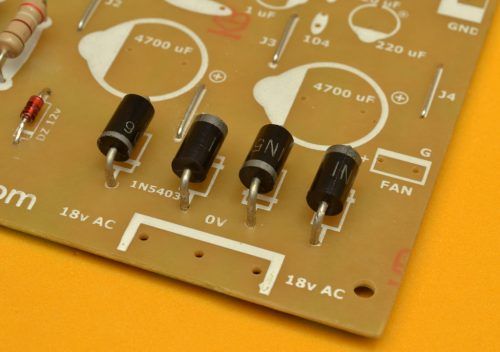
The base of the diode is p-n-junctionformed by semiconductor materials with two different types of conductivity. Two wires are connected to the diode crystal called cathode (negative electrode) and anode (positive electrode). There is a p-type semiconductor region on the anode side and an n-type semiconductor region on the cathode side. This diode device gives it a unique property — current flows in only one (forward) direction, from anode to cathode. Conversely, a normally operating diode does not conduct current.
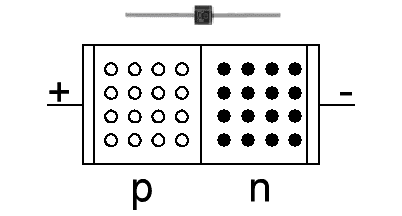
In the anode region (p-type) the main charge carriers are positively charged holes, and in the cathode region (n-type) negatively charged electrons. The diode leads are contact metal surfaces to which the wires are soldered.
When the diode conducts current in the forward direction, it means that it is in the open state. If the current does not pass through the p-n-junction, then the diode closes. Thus, the diode can be in one of two stable states: open or closed.
By connecting the diode in the DC voltage source circuit, the anode to the positive terminal and the cathode to the negative terminal, we obtain the forward bias of the pn-junction. And if the source voltage turns out to be sufficient (0.7 volts is enough for a silicon diode), then the diode will open and begin to conduct current. The magnitude of this current will depend on the magnitude of the applied voltage and the internal resistance of the diode.
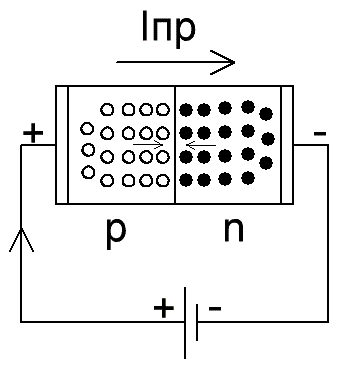
Why did the diode go into the conducting state? Because with the correct switching on of the diode, the electrons from the n-region, under the action of the EMF of the source, rushed to its positive electrode, to the holes from the p-region, which now move to the negative electrode of the source, to the electrons.
At the border of the regions (at the p-n-junction itself) at this time there is a recombination of electrons and holes, their mutual absorption. And the source is forced to continuously supply new electrons and holes to the p-n junction region, increasing their concentration.
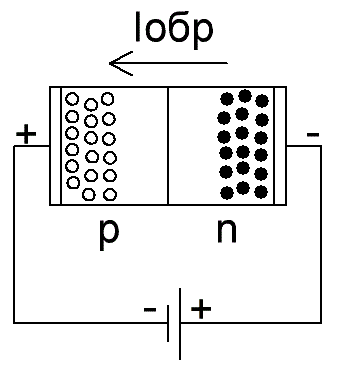
But what if the diode is reversed, with the cathode to the positive terminal of the source and the anode to the negative terminal? Holes and electrons scatter in different directions—towards the terminals—from the junction, and a region depleted of charge carriers—a potential barrier—appears near the junction. Current caused by most charge carriers (electrons and holes) simply will not occur.
But the diode crystal is not perfect; in addition to the major charge carriers, it also has minor charge carriers in it that will create a very negligible diode reverse current measured in microamperes. But the diode in this state is closed because its p-n junction is reverse biased.
The voltage at which the diode switches from the closed state to the open state is called the diode forward voltage (see — Basic parameters of diodes), which is essentially the voltage drop across the p-n junction. The resistance of the diode to the forward current is not constant, it depends on the magnitude of the current through the diode and is of the order of several ohms. The reverse polarity voltage at which the diode turns off is called diode reverse voltage. The reverse resistance of a diode in this condition is measured in thousands of ohms.
Obviously, a diode can switch from an open state to a closed state and vice versa when the polarity of the voltage applied to it changes. The operation of the rectifier is based on this property of the diode. So in a sinusoidal AC circuit, the diode will conduct current only during the positive half-wave and will be blocked during the negative half-wave.
See also on this topic:What is the difference between pulse diodes and rectifier

